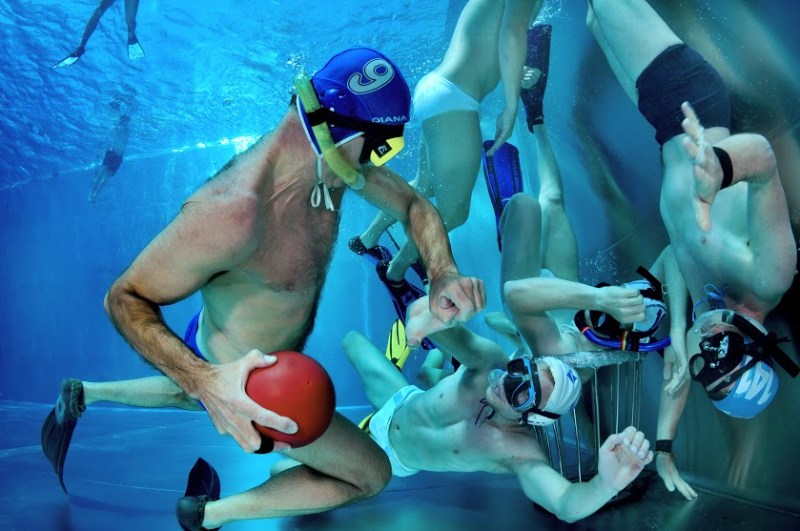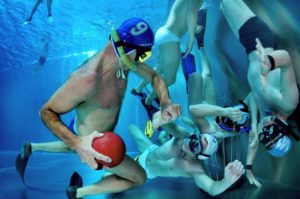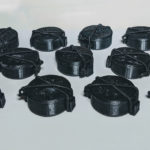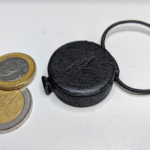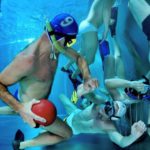Since July 2016, I have been an active member of the Graz Underwater Rugby team. As per Wikipedia, underwater rugby (UWR) is an underwater team sport. During a match, two teams try to score a negatively buoyant ball (filled with saltwater) into the opponents’ goal at the bottom of a swimming pool. It originated from within the physical fitness training regime existing in German diving clubs during the early 1960s and has little in common with rugby football except for the name. It was recognized by the Confédération Mondiale des Activités Subaquatiques (CMAS) in 1978 and was first played as a world championship in 1980.
An attack in underwater rugby
Like in most sports, several factors influence the athletic performance of a player, such as the overall strength, speed and stamina. Most of these factors can be measured and tracked with well established methods. Even measuring a players functional performance in a certain match is possible, and is done by e.g. counting the number of passes, goals scored, distance covered, etc. Underwater rugby is not that different from conventional sports when it comes to measuring these athletic and functional performance. UWR players get tested for strength and stamina on a regular basis.
Being a 3D sport, underwater rugby offers several other indicators of a players performance, such as the time spent under water actively participating in the game vs. time spent above water observing and catching ones breath. The more active time under water, the better the functional performance.
A lot of sports trackers are offered for conventional sports like running, swimming, football and tennis. I did not find anything applicable for underwater rugby – something that would measure how much time I spend in game, and how much on the water surface. Using a dive computer would not be the right option, as the wrist position does not necessarily correlate with the depth of a players head. Apart from that, underwater rugby has strict policies when it comes to equipment – anything which might endanger other players or yourself is not allowed. For this reason, wearing a dive watch around your wrist would not be legal, because it has hard, sharp edges which could cause an injury.
For the reasons above, I decided to build my own primitive sports tracker, a device which would measure the depth and movement of a player (his/her head, to be precise), in game. A player would place the (small) device in the earmuffs of their cap, and the device would periodically measure the water pressure, from which depth can be derived. The depth would indicate (I hope) if the player was above water grabbing air or under water playing. A players head movement would also be measured, although I am not sure how the movement measurement correlates with players performance and in what way I can use this data.
I decided to use a SESUB-PAN-D14580 IC by TDK, worlds smallest BLE SoC built around the DA14580 IC by Dialog Semiconductors and based on a Cortex M0. There are several reasons for using BLE as communication protocol. Due to wide acceptance of this protocol, most phones would be able to read out the data (if they have the right app), contrary to low level protocols where a PC would be needed. Another one is the absence of wires for communication – the device can be enclosed and easily protected from water.
A MS5837 pressure sensor by TE Connectivity would be used to measure the depth, and for the head movement data, I will use a LIS2DH accelerometer by STMicroelectronics.
SESUB-PAN-D14580 BLE SoC, MS5837 pressure sensor, LIS2DH accelerometer
The depth and the accelerometer data would be stored on an external Flash storage. Very little power would be required for the operation, so I hope a button cell would suffice for a few games.
Water pressure increases by around 0.98 mBar for every cm of water depth at 4°C. The MS5837 has a resolution of 0.2 mBar, which is more then enough for this application. As for the measuring frequency, I think between 5 Hz and 10 Hz should be enough – but this is is a parameter that can be changed. The less is measured, the less storage is used, thus, the device can measure for longer periods of time.
The device would start the measurement when it is submerged deeper than e.g. 10 cm. In order to detect a submersion, it would at all times need to know the current air pressure, because the 5 cm in water are cca. 5 mBar plus the current air pressure. After 10 minutes of inactivity (player not in water, sensor measures air pressure), the device would stop measuring and store the profile in the flash. I chose 10 minutes, because a timeout between halves usually takes 5 minutes, and I want to have both halves in one profile.
As for Bluetooth communication, device would advertise a bit faster for a few hours after the last profile was saved. Other than that, advertising interval needs to be low to save energy.
Bluetooth commands that the device should support are reading of dive profiles starting from a certain date and time, deleting all entries, resetting the device, setting parameters like the device name, measurement frequency. timeout, etc.
